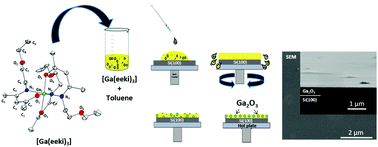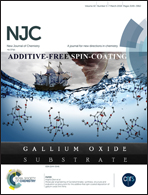Molecular engineering of Ga-ketoiminates: synthesis, structure and evaluation as precursors for the additive-free spin-coated deposition of gallium oxide thin films†
Abstract
A series of new homo- and heteroleptic gallium ketoiminate compounds, namely, tris[4-[2-(ethoxyethyl)imino]-2-pentanone] gallium(III) [Ga(eeki)3] [1], tris[4-[3-(methoxypropyl)imino]-2-pentanone] gallium(III), [Ga(mpki)3] [2], tris[4-[3-(methoxyethyl)imino]-2-pentanone] gallium(III), [Ga(meki)3] [3], dichloro[4-[(isopropyl)imino]-2-pentanone] gallium(III) [Ga(ipki)Cl2] [4], bisdimethylamido[4-[(isopropyl)imino]-2-pentanone] gallium(III) [Ga(ipki)(NMe2)2] [5] and chloro-(bis[4-[3-(ethoxypropyl)imino]-2-pentanone]) gallium(III) [Ga(epki)2Cl] [6], was synthesised through molecular engineering. The literature known compound chloro-(bis[4-[(isopropyl)imino]-2-pentanone]) gallium(III) [Ga(ipki)2Cl] [7] was synthesised for comparison. Confirmation of the successful formation and spectroscopic purity of the compounds was determined using nuclear magnetic resonance (NMR) spectroscopy, single crystal X-ray diffraction (XRD), electron ionisation mass spectrometry (EI-MS), and elemental analysis (EA). The thermal properties of the compounds were assessed with thermogravimetric (TG) analysis and revealed compound [4] was suitable for vapour phase deposition processes while the others displayed a decompositional behaviour favourable for solution based thin film deposition processes. The EI-MS fragmentation behaviour of compound [1], with its thermal properties, and excellent solubility in a wide variety of organic solvents, suggested that it was highly eligible to be applied for chemical solution deposition (CSD). Thus, compound [1] was applied for the spin-coating of Ga2O3 thin films without the need for additives or aging to stabilise the solution prior to processing. The as-deposited thin films were amorphous, while annealing under ambient conditions at higher temperatures (850–1000 °C) yielded β-gallium oxide as indicated by XRD. The morphology and composition were analysed by scanning electron microscopy (SEM) and Rutherford backscattering spectrometry (RBS) respectively, while the optical properties were determined using UV-vis spectroscopy and illustrated that films grown with a spin-cycle number <5 were highly transparent (>80%) in the visible range.



 Please wait while we load your content...
Please wait while we load your content...